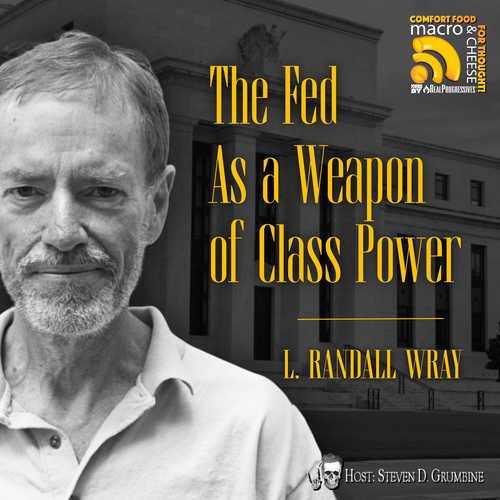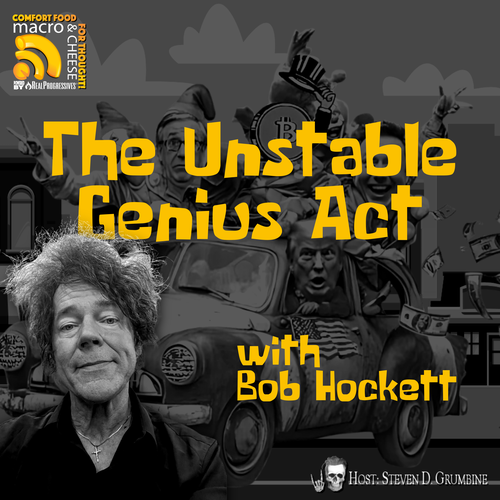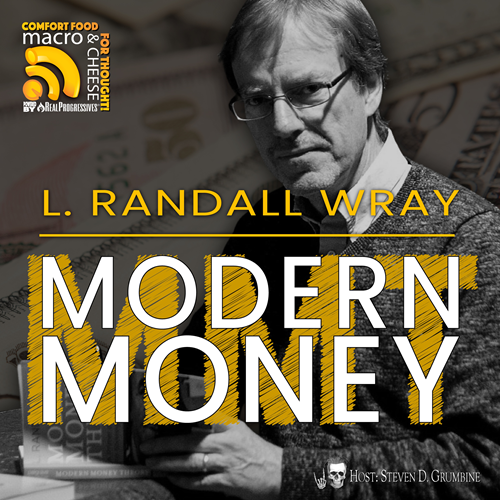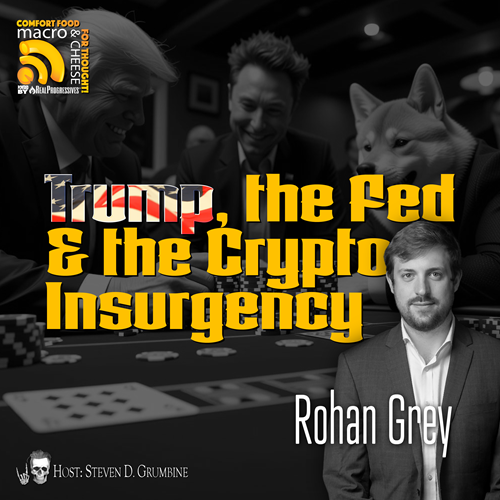Originally posted on December 9, 2012 at the New Economic Perspectives blog.
The Trillion Dollar Coin proposal for solving the debt ceiling problem is again experiencing a blogosphere explosion this past week. The precipitating factor may be that people are starting to believe that the Republicans will come to a “fiscal cliff” settlement with the Democrats including very little in entitlement spending; but will then come back, in 2013 with a very tough position on the price they want to agree to raise the debt ceiling to give the Executive operating room for any length of time. Bruce Bartlett had this to say on the issue:
In my opinion, the fiscal cliff is akin to the so-called Y2K problem in late 1999, when many people worried that computers would freeze, elevators would stop running and planes would fall from the sky. Of course, nothing of the kind happened.
So if the fiscal cliff is a faux problem, why do we hear that industry and financial markets are deeply fearful of it? The answer is that there is a very real fiscal problem that will occur almost simultaneously ñ expiration of the debt limit. Much of what passes for fiscal-cliff concern is actually anxiety about whether Republicans in Congress will force a default on the nation’s debt in pursuit of their radical agenda.
I think Bartlett is right about attention shifting to the debt ceiling now, and that’s why we have a sudden explosion interest in high value platinum coin seigniorage having face values mostly in the low trillions, once again. Since the Trillion Dollar Coin (#TDC) is being vetted again, I wanted to make a brief point about it that is not well understood by the mainstream bloggers who have been stampeding to blog about the PPCS solution this week. Let’s lay out the context.
Most people who’ve thought about how the Government creates money know that Congress delegated the primary power to create currency to The Federal Reserve Banks, the system of which combined with the Board of Governors and the Federal Open Market Committee, form the central bank of the United States. In modern times, currency means not only printed money, but also electronically created credits, reserves held in Federal Reserve accounts.
The reserves that have been created by the Fed at any point, are many multiples of the amount of paper currency in existence produced by the Mint on orders from the Fed. So, most of the currency created by the Fed is in the form of reserves rather than paper currency. Also it’s well-known that when the Fed creates reserves, it does so “out of thin air.”
In our fiat currency system there is no “backing” for either the reserves or the paper currency. In exactly that sense, all of our currency is now “printed,” and has been since we went off the gold standard in 1971. There is no distinction between existing currency, whether paper, or reserves, and newly created currency in that respect.
The Fed however, doesn’t make all our money. The Treasury too, has its role. Congress delegated the US Mint the authority to coin fiat money, the value of whose metal content, with respect to certain types of coins, need have no relation to its face value, which can be as high or low as the Mint wants to make it. However, this has created a problem.
If the Mint coins money in denominations appropriate for commonplace retail transactions than the coins involved can be exchanged among parties as needed. But what happens if the Mint coins platinum money with face values in the trillions of dollars? Then that money can’t be used for exchange as a practical matter, because there are no buyers who will accept the trillion dollar coins in exchange. So, if the Treasury wants to use such coins to fill the public purse with money it can later spend on debt repayment or Congressional deficit appropriations, it must transform high face value coins into divisible money; i.e. reserves in its Fed spending account.
Fortunately, since high value coins are legal tender, the Mint, and the Treasury, can force the Federal Reserve to transform high value coins into reserves, by just depositing them into the US Mint’s Public Enterprise Fund (PEF) account, which the Fed must credit with reserves in return for the high value coins.
For example, if the Mint deposits a $One Trillion coin in the PEF, then the Fed must accept the coin and credit the PEF with an equivalent value of electronic credits in reserves. Then, the Treasury has the authority to “sweep” the PEF of all seigniorage, i.e. profits resulting from the Mint/Fed transaction.
In the case of $One Trillion proof platinum coin, the profits are its face value minus a few thousand dollars. So that amount would be “swept” into the Treasury General Account (TGA), which is the account used by Treasury to perform Government spending.
A very good way to look at high value platinum coins is that they are legal instruments for the Treasury to use the unlimited “out of thin air” reserve creation authority of the Fed to fill the public spending purse, the TGA, for public purposes. In effect, platinum coin seigniorage involves the Treasury commandeering the power of the Fed to create reserves and place them in the TGA, perhaps, depending on what the Treasury chooses to do, in the many Trillions of dollars. Functionally, it produces the same result as if the Fed were subordinate to the Treasury within the Executive Branch, and the Treasury had unlimited authority to create both currency and coins by fiat. Is this good?
I think it is. The vaunted independence of the Fed has not served us well over the years. What it has amounted to is that the Fed has not been accountable to the public. Its independence has meant independence from the Treasury and, largely, from Congress. But it has not meant independence from the big banks and Wall Street, which the Fed fails to regulate to any visible extent to protect the economy and the public, and whose interests the Fed has served ahead of the interests of the public at large.
In short, I am all for the President ordering high value platinum coin seigniorage, because I think the constraints imposed by that upon the Fed, and also the filling of the public purse to such an extent that it will be clear to people that the US can never run out of the currency it alone can issue, will make the Congress, the Fed, and the Executive Branch all much more accountable to the wishes of the American people.
The Congress and the Executive won’t be able to hide behind “we’re running out of money” anymore, when they refuse to enact that majority support among the people. And the Fed won’t be able to hide behind its “independence” to justify its doing the bidding the big private banks. Using proof platinum coin seigniorage, will be better for supporting a progressive democracy; and ultimately, that is why I favor it!
31 RESPONSES TO “WHAT DOES THE TRILLION DOLLAR COIN DO?”
- Potomac Oracle | December 9, 2012 at 10:19 am |PPCS will be vehemently, indeed hysterically marginalized by the bond vigilantes. Can you imagine having the government snatch a trillions of dollars from your potential portfolio of interest paying securities? OMG, that is worthy of sustained war on Washington, billions spent to preserve trillions.Geithner has already dissuaded the President for that very reason. Check with Dean Baker, I got this from him.
- Joe Firestone (LetsGetitDone) | December 9, 2012 at 3:12 pm |But if he does the $60 T coin. Then the trick is done. What will they do? Say the US should not pay its debts? Turn the debt against them. That is the way to win! And Btw, according to CBO-based projections a couple of years ago, it was $11.8 T in interest through 2025. Of course, they’ll fight about it!
- Thomas Sewell | January 12, 2013 at 9:59 am |Under your theory, why not just do a $100 T coin and then give a one-time grant of the money to all U.S. residents? Then everyone will be rich!Starting to see yet why this may be a bad idea?
- golfer1john | January 12, 2013 at 1:10 pm |It’s not money until it is spent. The giving of $100T to the people would cause inflation, whether it is done by minting a coin, or selling T-bills and having the Fed buy them, or just spending it without coins or T-bills. Holding it in an account would not affect the economy at all. Spending is controlled by the Congress. Existence of the coin does not obligate them to increase spending.
- Thomas Sewell | January 12, 2013 at 2:15 pm |If they pay off the debt with the money from the coin, the money used to redeem the bonds will enter the economy. What’s the point of the coin, if not to use it to increase spending past the current debt limit?
- golfer1john | January 12, 2013 at 3:15 pm |“What’s the point of the coin, if not to use it to increase spending past the current debt limit?”Read some more Dan Kervick and Joe Firestone on the coin. The really valuable effect would be to get people to think a little bit outside their boxes, and realize that money comes from government, and thus government doesn’t need to borrow that which it can create for nothing; that a monetarily sovereign government can never be forced into bankruptcy, that the balances in the savings accounts it offers (aka Treasury securities) is not a danger to it, that large economies need more money than small ones, so that a growing economy needs a continuous addition of money, and that government’s so-called deficit is actually the non-government surplus.Then the very existence of the coin becomes moot. The debt limit bill would be repealed. The law requiring the gap between taxing and spending to be filled with new Treasury securities would be repealed. Spending would be in accordance with public purpose, without regard to finance, and taxing would be governed by such variables as unemployment and inflation, not debt and deficit. Issuance of new Treasuries would be done in concert with the Federal Reserve’s management of the interest rate, not in response to taxes and spending.The manufactured debt limit crisis is just an opening for this new way of thinking to spread.
- golfer1john | January 12, 2013 at 3:15 pm |“What’s the point of the coin, if not to use it to increase spending past the current debt limit?”Read some more Dan Kervick and Joe Firestone on the coin. The really valuable effect would be to get people to think a little bit outside their boxes, and realize that money comes from government, and thus government doesn’t need to borrow that which it can create for nothing; that a monetarily sovereign government can never be forced into bankruptcy, that the balances in the savings accounts it offers (aka Treasury securities) is not a danger to it, that large economies need more money than small ones, so that a growing economy needs a continuous addition of money, and that government’s so-called deficit is actually the non-government surplus.Then the very existence of the coin becomes moot. The debt limit bill would be repealed. The law requiring the gap between taxing and spending to be filled with new Treasury securities would be repealed. Spending would be in accordance with public purpose, without regard to finance, and taxing would be governed by such variables as unemployment and inflation, not debt and deficit. Issuance of new Treasuries would be done in concert with the Federal Reserve’s management of the interest rate, not in response to taxes and spending.The manufactured debt limit crisis is just an opening for this new way of thinking to spread.
- Thomas Sewell | January 12, 2013 at 2:15 pm |If they pay off the debt with the money from the coin, the money used to redeem the bonds will enter the economy. What’s the point of the coin, if not to use it to increase spending past the current debt limit?
- golfer1john | January 12, 2013 at 1:10 pm |It’s not money until it is spent. The giving of $100T to the people would cause inflation, whether it is done by minting a coin, or selling T-bills and having the Fed buy them, or just spending it without coins or T-bills. Holding it in an account would not affect the economy at all. Spending is controlled by the Congress. Existence of the coin does not obligate them to increase spending.
- Thomas Sewell | January 12, 2013 at 9:59 am |Under your theory, why not just do a $100 T coin and then give a one-time grant of the money to all U.S. residents? Then everyone will be rich!Starting to see yet why this may be a bad idea?
- Joe Firestone (LetsGetitDone) | December 9, 2012 at 3:12 pm |But if he does the $60 T coin. Then the trick is done. What will they do? Say the US should not pay its debts? Turn the debt against them. That is the way to win! And Btw, according to CBO-based projections a couple of years ago, it was $11.8 T in interest through 2025. Of course, they’ll fight about it!
- Jonf | December 9, 2012 at 11:24 am |I like it. But do you think Obama, Timmy and the Dems have what it takes to do it? I’ve not,heard anything about this from our political class?? I think it is doubtful they ” never heard of it” since it is all over the Internet. I remain hopeful they use it to forever break the grip of an “independent” fed or congress.
- Joe Firestone (LetsGetitDone) | December 9, 2012 at 3:14 pm |I don’t think so. But I think we need to pressure them to do it and not focus on what we think they might accept. You never know what you can get until you ask for it and fight for it. So, let’s do that!
- Aquifer | December 9, 2012 at 9:40 pm |And what, precisely, will we do if they don’t?
- Aquifer | December 9, 2012 at 9:40 pm |And what, precisely, will we do if they don’t?
- Joe Firestone (LetsGetitDone) | December 9, 2012 at 3:14 pm |I don’t think so. But I think we need to pressure them to do it and not focus on what we think they might accept. You never know what you can get until you ask for it and fight for it. So, let’s do that!
- joebhed | December 9, 2012 at 11:30 am |Great job. Much improved scrivening.Suffice to say that any method of REAL money creation by the Treasury, acting on authority of the Congress, will catapult both the fiscal cliff and the e’er present debt-ceiling into oblivion, and this will enable the Restofus to ponder delivering the wealth being produced to a whole different breed of stakeholders. Thought I’d drag up that old word again.
But unless accompanied by true reform, even achieving the TDC (thanks for that) would not solve the problem that is causing the present debt-deflation crisis, the crippling saturation of the economy with debt by the fractional-reserve bankers. It is the private debt in this country that threatens our free-market based ability to prosper, not the public debt.
“”Most people……….. know that Congress delegated the primary power to create currency to The Federal Reserve Banks,””. While true, actually, most people don’t know that. They think the government creates the money. Take a poll.Reform to the system of money and government finance MUST include the end to the presently constructed private federal-reserve banking system. This could be accomplished by separating the money-creation from banking functions, and placing the full money-creation functions within Treasury, with issuance administered by a Federal Reserve branch that maintains the payments system and provides the minimal regulation required of a private banking system that operates, again, on a real-money basis.The idea that we can have two “money creation and issuance powers”, one public and one private, is only slightly more mind-bending than the claim that this is what we have now.For this reason, the TDC option represents a convoluted way to accomplish that which MMT purports to be its object. If it is agreed THAT the government has the ultimate power to create the money, then by definition it has the authority to create all the money.
If the government has the authority to create ANY of all of that money without issuing any debt – and both the TDC and Greenbacks are examples of creating new money without issuing any debt, then
the government has the right to issue all of the money without issuing any debt.We’re pretty much home free after that.
Thanks.- Joe Firestone (LetsGetitDone) | December 9, 2012 at 3:16 pm |See the next one, Joe.
- Joe Firestone (LetsGetitDone) | December 9, 2012 at 3:16 pm |See the next one, Joe.
- jerry | December 9, 2012 at 11:34 am |I think fiscal cliffs and debt ceilings will continue to be mainstays of the political machinery right now, at least for the right. I think we will go over the cliff, enact some minor tax/spending legislature, and then set out another date a year down the road to face the “problem” again. It is extraordinarily useful to the neoliberal model to always have some near or not-so-distant debt time-bomb to combat any new ideas of government spending or similarly “socalist” agendas. “Well, we’ve gotta deal with the debt first, we can’t start that jobs program”. As long as that line is in the neoliberal back pocket, they can avoid any threat to continued privatization or usurious debt peonage.
- Joe Firestone (LetsGetitDone) | December 9, 2012 at 3:17 pm |Maybe so. But let’s fight them about it!
- Joe Firestone (LetsGetitDone) | December 9, 2012 at 3:17 pm |Maybe so. But let’s fight them about it!
- JK | December 9, 2012 at 12:10 pm |Joe,It seems like the Platinum Coin idea would make it unnecessary to increase the budget deficit, i.e. issue more Treasuries, ‘from the onset’, BUT, if the Fed is targetting a FFR above zero, then the budget deficit will increase, i.e. more Tresuries wil need tol be issued, ‘after the fact,’ in order to prevent the FFR from collapsing to near zero.I understand the current environment is different with the Fed pay interesst on excess Reserves, but would you say that my description above would be accurate in a situation where the Fed is targeting an FFR above zero?
- Golfer1john | December 9, 2012 at 1:36 pm |There would be no specific need for new treasuries, the Fed could sell some of its holdings in order to drive the interest rate up from zero. Eventually, though, if the Fed runs out then new ones would need to be issued, but if they are issued only to refi the ones maturing, then the total outstanding does not increase.
- JK | December 9, 2012 at 3:33 pm |Golfer,Right… you’re getting to my point. So long as the Fed as Tresuries on it’s books, it could sell them as a Reserve drain. But sooner or later, if the Tresury continued to mint platinum and spend directly into the economy, there would come a point where the Fed has ‘run out’ of Treasuries and new ones would need to be issued, so long as the FFR target is above zero.So, what I’m asking is, up until that point it seems that no ned “deficit” spending would need to occur, but once that point is reach, the point where the Fed has ‘run out’ of Treasuries on it’s books, then from then onward new tresuries would need to be issued as all new spending flushed the banking system with Reserves that would drive the FFR down to zero.I suppose this could be solved by no longer using open market operations in order to target the FFR, and instead just set the lower bound as it’s done now… interest on reserves, right?
- Golfer1john | December 9, 2012 at 4:34 pm |Why is zero a bad FFR? Mosler says the natural rate of interest is zero.
- JK | December 9, 2012 at 4:58 pm |Golfer, I’m not saying its bad or good. I’m just trying wrap my mind around the result of different actions, for better or worse. No value judgements in my comments.
- JK | December 9, 2012 at 4:58 pm |Golfer, I’m not saying its bad or good. I’m just trying wrap my mind around the result of different actions, for better or worse. No value judgements in my comments.
- Golfer1john | December 9, 2012 at 4:34 pm |Why is zero a bad FFR? Mosler says the natural rate of interest is zero.
- JK | December 9, 2012 at 3:33 pm |Golfer,Right… you’re getting to my point. So long as the Fed as Tresuries on it’s books, it could sell them as a Reserve drain. But sooner or later, if the Tresury continued to mint platinum and spend directly into the economy, there would come a point where the Fed has ‘run out’ of Treasuries and new ones would need to be issued, so long as the FFR target is above zero.So, what I’m asking is, up until that point it seems that no ned “deficit” spending would need to occur, but once that point is reach, the point where the Fed has ‘run out’ of Treasuries on it’s books, then from then onward new tresuries would need to be issued as all new spending flushed the banking system with Reserves that would drive the FFR down to zero.I suppose this could be solved by no longer using open market operations in order to target the FFR, and instead just set the lower bound as it’s done now… interest on reserves, right?
- Joe Firestone (LetsGetitDone) | December 9, 2012 at 3:20 pm |I think the Fed could handle that by paying higher interest on reserves. In fact, with PCS, the Treasury could refuse to issue debt and just have the Fed pay that interest. Then no one can that there is national debt. Politically, having low or no debt is powerful among the people.
- JK | December 9, 2012 at 3:35 pm |Joe, Thanks for the response. I didn’t see your response before I responded to Golfer.
- JK | December 9, 2012 at 3:35 pm |Joe, Thanks for the response. I didn’t see your response before I responded to Golfer.
- Golfer1john | December 9, 2012 at 1:36 pm |There would be no specific need for new treasuries, the Fed could sell some of its holdings in order to drive the interest rate up from zero. Eventually, though, if the Fed runs out then new ones would need to be issued, but if they are issued only to refi the ones maturing, then the total outstanding does not increase.
- justaluckyfool | December 9, 2012 at 1:15 pm |Joe Firestone,”it will be clear to people that the US can never run out of the currency…”This message seems to be gaining ground and may become a known fact.
Even the Fed has officially proclaimed “limitless issue”
(Google-“Can Fed Run Out of Money?”)“currency it alone can issue…”Here is where we may have a difference of opinion. The Private for Profit Banks (PFPB) now play a gigantic role in not only creating money but also doing it it such a manner that it could create a financial Armageddon – a ” systemic failure”.
This may even be considered a self imposed by legislation the giving away the right to “currency it (the Monetary Sovereignty) alone can issue. Thereby creating a hazard that could destroy the value of that currency. That is ” credit expansion by ‘fictitious lending’”, as per Frederick Soddy (The Role Of Money).“The Trillion Dollar Coin proposal for solving the debt ceiling problem..”
Would not be a solution because the “debt ceiling ” is not a problem. This self imposed restriction is either changed at will or ignored. The Fed has PROVEN that by Quantitative Easing (QE) it can issue $100’s of trillions that are not counted as deficit spending, and rightfully so,since an asset purchase is just that -an asset. (Google: Fed LIST of name and amount $16 trillion to banks)
However I would love to see two $100 trillion coins minted and placed on display; one next to the US Constitution, the other next to the Liberty Bell, after they are electronically deposited.Justaluckyfool wishes to ask the question ,
What if…
Change the beneficiary of QE from that of for the 1% to the benefiting of the100%.
Instead of profits for the PFPB; revenue raised for the common bettering of all.& t.oneAs Einstein said, “Keep It Simple”.
Cut federal income taxes to zero. Pay off the budget deficit at $1 trillion per year and have $4.5 trillion to spend each year for the next 36 years.
All this can be done without any new legislation.
The Federal Reserve Bank already has the ways and means. Almost all economist agree that the Feds can purchase an unlimited amount of assets it needs , and at no increase in deficit spending.
****”QE 4 Bank Solvency” $100 trillion- one of two:
The Federal Reserve Bank can mandate a change in reserve requirements for all private for-profit banks, that is from the present 10% to 100%.
To prevent a collapse of the financial system it would make $100 trillion available as Loans to the industry with a rate of 2% for 36 years.
As law ,”All profits from the Federal Reserve Bank are to go to the US Treasury”.
That means a REVENUE STREAM OF $5.5 TRILLION OVER THE NEXT 36 YEARS.
*****QE 4 Residential and Commercial Real Estate Loans” $100 trillion- two of two.
The Federal Reserve Bank can purchase all residential and commercial real estate loans by making up to $100 trillion available. Modify all the loans with a new assumable mortgage with a rate of 2% for a term of 36 years. Thereby making all loans affordable, stopping foreclosure and stabilizing the construction sector. This means a REVENUE STREAM OF $5.5 TRILLION OVER THE NEXT 36 YEARS.
RESULT: $11 trillion per year “revenue raised instead of federal income taxes”Google: Justaluckyfool who asks,”Why would you not want prosperity for your self and your children.”?
PLEASE, challenge,change,make it better then use it as a guide.- Joe Firestone (LetsGetitDone) | December 9, 2012 at 3:26 pm |JLF, some good ideas here. But it’s very complex so it would take some time to evaluate. You may like my next Post, but as for the Fed. I don’t like it, because it is an undemocratic elitist institution. It should not be the locus for major policy changes w/o relocating it into Treasury first.
- Joe Firestone (LetsGetitDone) | December 9, 2012 at 3:26 pm |JLF, some good ideas here. But it’s very complex so it would take some time to evaluate. You may like my next Post, but as for the Fed. I don’t like it, because it is an undemocratic elitist institution. It should not be the locus for major policy changes w/o relocating it into Treasury first.
- Andrew | December 9, 2012 at 1:17 pm |This is incredible silliness. The notion that any part of the US government would/has to resort to this kind of childishness is absurd. The notion of a trillion dollar coin makes no more sense than the notion of running out of points to play the fourth quarter of a football game.
- Joe Firestone (LetsGetitDone) | December 9, 2012 at 3:28 pm |Andrew, the part of the Government that can’t run out of points is the Fed. What the coin does is to commandeer the Fed’s power on behalf of the Treasury. After that is done, then the Treasury won’t be able to run out of points, either.
- Andrew | December 9, 2012 at 4:56 pm |Yes, I understand. But it is absolute silliness. To the point of being worthy for Monty Python. Can the adults in the room stand up and talk to one another? Can’t the President call Ben and say “write off the deficit, please” and have it done? Is that really any different than making a coin and taking it to the Fed? A platinum coin perpetuates the notion that money is a real thing. Grownups can see otherwise.
- Golfer1john | December 9, 2012 at 6:33 pm |” Can’t the President call Ben and say “write off the deficit, please” and have it done?”No, that wouldn’t be legal. There is a specific provision in the law for the Secretary of the Treasury to mint platinum coins of whatever value he determines. To do so would avoid some of the silliness we have now.
- Golfer1john | December 9, 2012 at 6:33 pm |” Can’t the President call Ben and say “write off the deficit, please” and have it done?”No, that wouldn’t be legal. There is a specific provision in the law for the Secretary of the Treasury to mint platinum coins of whatever value he determines. To do so would avoid some of the silliness we have now.
- Andrew | December 9, 2012 at 4:56 pm |Yes, I understand. But it is absolute silliness. To the point of being worthy for Monty Python. Can the adults in the room stand up and talk to one another? Can’t the President call Ben and say “write off the deficit, please” and have it done? Is that really any different than making a coin and taking it to the Fed? A platinum coin perpetuates the notion that money is a real thing. Grownups can see otherwise.
- Joe Firestone (LetsGetitDone) | December 9, 2012 at 3:28 pm |Andrew, the part of the Government that can’t run out of points is the Fed. What the coin does is to commandeer the Fed’s power on behalf of the Treasury. After that is done, then the Treasury won’t be able to run out of points, either.
- joe_h | December 9, 2012 at 3:16 pm |Is there anything stopping the Fed from just pro-actively crediting the treasury’s account? If the Fed wants to buy pencils, they simply credit office depot’s account, correct? How do they keep the books balanced from a double-entry book keeping point of view?
- Golfer1john | December 9, 2012 at 4:40 pm |When the Fed buys pencils, it would be acting like any other government department would do, and not as the Central Bank. They probably have a checking account somewhere that they use to buy pencils with. Not the same way they buy financial assets in open market operations.
- Golfer1john | December 9, 2012 at 4:40 pm |When the Fed buys pencils, it would be acting like any other government department would do, and not as the Central Bank. They probably have a checking account somewhere that they use to buy pencils with. Not the same way they buy financial assets in open market operations.
- BobbyG | December 9, 2012 at 5:29 pm |“In short, I am all for the President ordering high value platinum coin seigniorage”
__I would bet with confidence that it will not happen. The House would easily and “angrily” vote to Impeach, and that circus would suck all of the oxygen (what little remains) out of public discourse. There’d be Lynch The Kenyan dummies in every front yard in every state in Ol’ Dixie.The Haircut cannot just magically disappear, and those in the crosshairs of such a move are not gonna let it happen.









